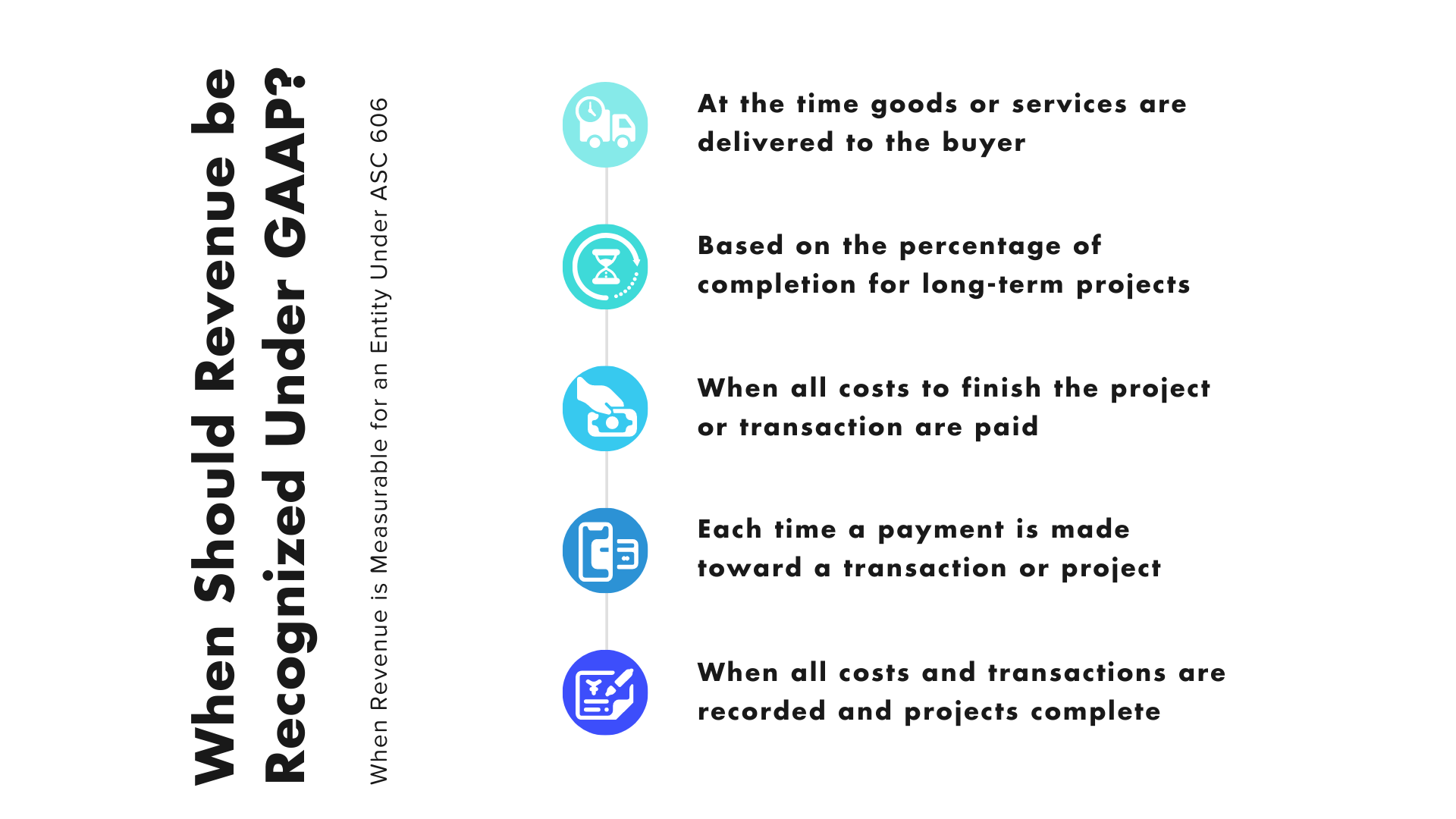Below you’ll find a quick summary and outline. Then you'll find step-by-step instructions to help you learn how to implement the new ASC 606 accounting guidelines.
With ASC 606, How is Revenue Recognized?
In a nutshell, ASC 606 is the new Accounting Standards Codification (ASC) outlined by the Financial Accounting Standards Board (FASB) for GAAP accounting professionals. Compared to the previous codification, updates require more detailed, comprehensive disclosures for revenue recognition.
In alignment with traditional standards, new rules require evidence of a financial agreement, delivery of a product or service, a fixed or measurable price to the buyer, and reasonably collectible funds.
What is the Effective Date of ASC 606?
The ASC 606 effective date, formally for most public businesses, was January 1, 2018. For all nonpublic entities, the new codification goes into effect for the calendar year ending December 31, 2020. So, there’s no time left to waste.
What are the Five Steps in the Revenue Recognition Process?
The new FASB revenue recognition criteria are laid out in five steps:
- Identify the contract with a customer
- Identify the performance obligations in the contract
- Determine the transaction price
- Allocate the transaction price
- Recognize revenue when or as the entity satisfies the performance obligation
While these steps seem straightforward enough at first glance, they leave out the preparation and operational changes that must be made for compliance. So, here’s what you need to do.
Step 1: Design Your Data Set to Support ASC 606
When accounting for commissions, you must first ensure that commission can be assigned to all sales records. Furthermore, they must be assigned at each level of credit. So, for Account Executives up to the VP of sales, each credit must be recognized.
Furthermore, you need a process that captures the contract start and length for all commission records. Then, categorize all sales with product types. Is it a renewal, new subscription, or something else?
Keep in mind that product types should be classified in a way that anticipates various ASC 606 treatments. This means that contracts, obligations, and prices need to be included in a way that bends for multiple recognition methods.
Step 2: Establish a Dedicated Ruleset to Handle ASC 606
With your new outline, a dedicated ruleset needs to be established in alignment with new standards. This ruleset must calculate expense allocations per sales record.
Take this one step at a time, starting from the ground up. Don’t get hung up on special report formats at this point. Once you’ve got the hang of how to implement the new standards, you can worry about creating multiple reports and views.
Step 3: Identify Contracts
For GAAP accounting, contracts are identified as the financial agreement between two parties. In the case of any entity, a contract is an agreement between the company or organization and the customer. In the case of commissions, an individual might be on the opposite side of the entity, but the idea is still the same.
Here, contracts should be identified when an agreement has been made, and the entity can determine both parties’ rights and payment terms. The contract must have a commercial substance that is expected to change the entity’s cash flow.
Step 4: Identify Performance Obligations in the Contracts
What are the performance obligations? Will the entity deliver a product or a service? What product or service will be delivered, and are there any stipulations?
Here, reasonable deadlines and other details should be established. Long-term contracts are naturally going to require a more complex approach than short-duration transactions.
For example, a performance obligation between an entity and a customer for an in-store product sale is immediate. The customer purchases a good from the entity and walks out of the store with the item. In this case, the performance obligation has been fulfilled.
On the other hand, a long-term service contract may be fulfilled over any length of time. On a five-year contract, for example, the entity might have any number of responsibilities to perform before the final goal has been achieved.
Step 5: Determine Transaction Price(s)
Again, transaction prices are more straightforward on immediate rather than long-term contracts. Here, data and rulesets need to allow multiple transaction price formats based on the type and length of the contract. Commissions and other transactions that are paid in percentages require more complex planning.
Step 6: Allocate Transaction Price(s)
Important: Determination and allocation are not mutually exclusive. The respective section of FASB’s ASC 606 framework that outlines allocation for transaction prices states that a contract in which multiple performance obligations are determined should allocate a transaction price to each obligation.
In laymen’s terms, this means that transactions must be categorized based on each obligation outlined in a contract. And, accounting terms for individual contract obligations can be simplified only to the extent that enables reasonably detailed reporting.
Step 7: Recognize Revenue
Now, it’s time for final calculations. The revenue recognition method that is used by the entity will determine the financial outcomes.
So, When Should Revenue be Recognized Under GAAP?
FASB’s new accounting framework doesn’t change when revenue may be recognized. So, when a critical, income-generating event has occurred, and the amount is recognizable to the entity, revenue can be recognized.

This includes sales basis, cash, accrual, deferred revenue, and all other accounting methods, which are chosen on a case-by-case basis.
Final Thoughts
Implementation of ASC 606 involves a learning curve for even the most seasoned accountants. It can feel daunting while you are getting the hang of it. Use the steps above to get started.
Performio’s platform collects all granular data needed to meet new revenue recognition standards:
- Asset balance
- PTD amount expenses
- Amortization amount
- The period in which commission was paid
- Product category
- Total commission paid
The system can help you automate sales commission calculations and reporting, for even the most complex compensation plans.
Request a demo today and let Performio help you manage your ASC 606 commissions. Performio includes the full tool kit of data management, calculation, and reporting capabilities to meet your ASC 606 requirements.
